Elvis E. Fleming, author of Captain Joseph C. Lea, From Confederate Guerrilla to New Mexico Patriarch, gave a presentation and book-signing in the beautiful setting of Lavender Spring Ranch at Arabela in the Hondo Valley Saturday, August 17. The hosts, Beth and Cliff Crouch, served guests lavender tea and cookies. Fleming’s talk about J.C. Lea, known as the patriarch of Roswell, was well-received and he sold 25 autographed copies of his various historical books that he had with him.
The history of J.C. Lea’s ranch headquarters, then named Agua Azul Ranch, was included in Fleming’s talk. Lavender Spring Ranch is now the setting of what had been Lea’s Agua Azul Ranch. (Aqua Azul means blue water.)
Following is the history of Lea’s ranch and some of his other holdings, excerpted from the notes of the talk Fleming gave at Lavender Spring Ranch, which he titled J.C. Lea and the Lincoln Connection:
“The federal government program which made it possible for Lea to buy public lands, started in 1870, when lands along the Canadian and Hondo rivers were offered at auction. Later, it was opened for ‘private filing.’
But Lea wanted to expand his operation. In 1883, he organized a partnership with several other people, none of whom lived in New Mexico. This company was the first “Lea Cattle Company.” The other partners furnished the finances, while Lea earned his twenty percent interest by working as general manager for the company. Few records of this company are known to exist.
Two years after forming the partnership, Lea set his sights on still bigger stakes. Horace K. Thurber was a wealthy investor in New York. Like so many Eastern businessmen, Thurber was fascinated by the idea of investing in Western cattle ranches. Together with John C. DeLany, post trader at Fort Stanton and former partner of Will Dowlin in Lincoln, Thurber incorporated the El Capitan Land and Cattle Company in April 1885.
Lea contacted Thurber with an optimistic proposal for another big ranch at the same time that Thurber and DeLany were forming their company. The articles of incorporation of Lea Cattle Company include the names of Horace Thurber, Lea, DeLany, and Charles S. Thurber, Horace’s brother. The document, dated April 20, 1885, declares that the purposes of the corporation were ‘… breeding, raising, buying and selling cattle and other domestic animals, and buying and selling merchandise.’ The capital stock was $1,000,000 in ten thousand shares. The letterheads and bonds of the company pictured cattle and horses bearing the ‘L-E-A’ and ‘H-K-T brands. They called the ranch ‘Agua Azul Ranch,’ after a pool where one Jesús Maes had settled in 1878 at the eastern foot of the Capitán Mountains. The letterhead defines the company range as ‘Agua Azul, Rio Hondo, and Rio Pecos, Lincoln County.’
The corporation designated Fort Stanton as its headquarters. Thurber invested $500,000 in cattle and another $250,000 to buy additional land with water rights. On June 26, 1885, the old Lea Cattle Company sold 3,364 acres of ranchland to the new Lea Cattle Company for $250,000. The new company bought 116 horses and mules from the old company. Thurber’s money was used for the operation of the ranch as well as buying land and water rights. Lea sold nine thousand cattle to the company for a quarter-million dollars. The company paid Lea $90,000 for 1,440 acres of his land, the largest of several such transactions.
The expansion of Lea Cattle Company was quite successful. On September 7, 1885, the Las Vegas Daily Optic stated, ‘Captain Lea controls fifty miles of river frontage and numerous springs in Lincoln County.’ The ranch ran 30,000 to 50,000 head of cattle. George Curry wrote that after he was elected assessor of Lincoln County in 1890, he found that the Lea Cattle Company ranch, with 40,000 cattle, was the largest cattle owner in the county and probably in the Territory. They also used the open range public lands, where their cattle ran more-or-less together with everybody else’s cattle.
The cattle company soon started plans to develop and sell their lands to farmers and other settlers, so the Roswell town-site was platted in 1885. Because of existing buildings, there are some irregularities in the blocks and a slight disorientation of Main Street from the compass.
An important development was irrigation ditches to ensure that Lea’s lands would have access to water. In 1879, he began to build diversion dams to take ditches out of the North Spring River, which flowed just north of the town-site. Four of the ditches built by Lea and his numerous partners continued to flow across downtown Roswell well into the 20th century.
While he was developing his ranch and related projects, Captain Lea married for the third time on April 29, 1889. Mabel Doss Day was a widow and the proprietor of a large cattle ranch (77,550 acres) in southwestern Coleman County. She was known statewide as the “Cattle Queen of Texas.”
The cattle country had summer droughts and winter blizzards from 1885 to 1887. The bottom fell out of the cattle market, and only those with large holdings and plenty of cash reserves were able to survive. Lea apparently continued to build his cattle empire even in the face of low cattle prices.
Improvement in the finances of the cattle country was painfully slow. A severe drought hit the southern plains in 1892-93, adding to the problems. Finally, the Panic of 1893 ended the recovery.
The Lea Cattle Company was already taking actions to escape financial ruin. They agreed in October 1892 with J. J. Hagerman of Colorado Springs to sell to Hagerman all of the company’s land and water rights in Chaves County outside of Roswell for $100,000. The transaction consisted of more than sixty-five tracts of land, plus total or partial interest in seven different irrigation ditch systems. In March 1893, the purchase of 11,004 acres was completed; this was not “all” of the company’s lands in Chaves County, as called for in the earlier motion. Other tracts were sold to Hagerman over the years from 1894 to 1900.
The reason for the sell-off was that Thurber gave up hope of ever recovering the hundreds of thousand of dollars he had invested in New Mexico. He stopped all funding and let the ranches fend for themselves.
Apparently, the company’s Chaves County business, after the 1893 transactions, consisted of buying and selling farmland and city lots. What these developments portended for the future of the Lea Cattle Company is unknown. The Lea Cattle Company owned thousands of acres of land in Lincoln County, but in the absence of records it is not clear what the status of the company ranch was in that county.
The cattle company had issued 150 bonds to H. K. Thurber on July 1, 1885, but they ceased redeeming coupons, payable semi-annually with 6% interest, after 1891. The company continued to wind down for several years. In a letter to his wife in November 1903, Lea indicates that he was disengaging from his business connections and planning to move to Texas where his wife was living. He never made the move; he died in February 1904.
After Lea’s death, there were some hot disputes between his widow and his daughter over his estate. While the wrangling was going on, the Lea Cattle Company finally bit the dust. The principal financier of the company, Horace Thurber, apparently died within a year or two of Captain Lea’s death. Thurber’s widow, Nancy Thurber, filed suit for the bonds and coupons: $232,500.
On February 9, 1906, the Fifth District Court in Roswell found in Mrs. Thurber’s favor and ordered the sheriffs of Chaves and Lincoln counties to seize “all of the assets” of the cattle company to satisfy the claim. It took a while to figure out just what the assets of the company were, but it was soon determined that the company’s assets in Lincoln County were much more extensive than those in Chaves County. Some 185 tracts of 40 acres each, totaling more than 7,000 acres, ranged from just east of Fort Stanton, scattered along both sides of the Río Bonito and Río Hondo, mostly south of the Hondo, and eastward to the Chaves County line. Lincoln County Sheriff John Owen offered the land for public auction at the front steps of the courthouse in Lincoln on August 7, 1906. Others bought small acreages, but the vast bulk of it went to Nancy Thurber for her high bid of $9,876.
In Chaves County there were four tracts of 40 acres each plus some city lots that belonged to Lea Cattle Company. Sheriff K. S. Woodruff offered the lands at auction to the highest bidder on the front steps of the courthouse in Roswell on August 18, 1906. Nancy Thurber bid $5,839 and received title to the property.
Mrs. Thurber was thus able to salvage some of the property that her husband had financed more than twenty years earlier. Thurber earned the dubious distinction of being one of the biggest financial losers in the cattle-grazing business.
================================
The development of the Pecos Valley caused a demand for new counties by the late 1880’s. Lincoln County was so large that it was inconvenient for people of the Valley to do business at Lincoln, the county seat. Capt. Lea took the lead in the movement to create two new counties: one in the vicinity of Roswell and one in the vicinity of Eddy. The bill creating Chaves and Eddy counties became law on February 25, 1889.
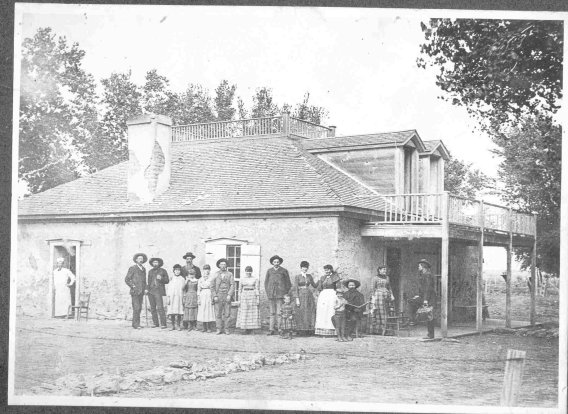
The first building in Roswell, originally a hotel built by Van C. Smith, it served as the J.C. Lea home as well as a boarding house. Photo courtesy of Elvis E. Fleming, archivist for Historical Society for Southeast New Mexico.
Meanwhile, Lea was busy developing his town. Roswell’s population was 343 in the census of 1890. Roswell was incorporated as a town in July 1891.
Lea and his third wife Mabel initiated the founding of Goss Military Institute in Roswell in 1891. It became New Mexico Military Institute in 1893, and is still one of the nation’s foremost military academies.
Lea was more than the Father of Roswell. The many recognitions bestowed upon him during his lifetime reflect the high regard that his fellow New Mexicans had for him. After his death, his friends continued to honor his memory. The most notable monuments to him are Lea Avenue in Roswell, Lea Hall at NMMI, Lea Lake at Bottomless Lakes State Park, and Lea County, created in 1917.
J. C. Lea started his adult life as a Confederate guerrilla and went on to become a large-scale cattleman in New Mexico and the patriarch of Roswell and Chaves County.”
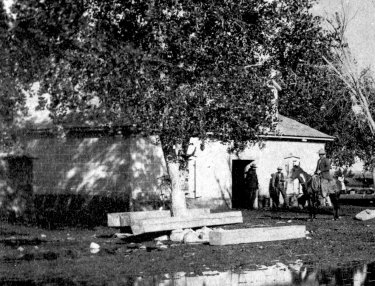
Lea, Bonney and Co.; this photo of the store, one of the first four buildings in Roswell, was taken in 1883. Photo courtesy of Elvis E. Fleming, Archivist for Historical Society for Southeastern New Mexico.
Based upon this photo, Fleming has doubts the building was adobe, as most people have believed. In photo, construction appears to be some type of concrete block.
ADDITIONAL ARABELA HISTORY
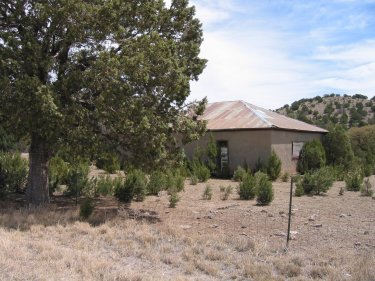
Old school house at Arabela
THE FRESQUEZ FAMILY AT ARABELA
The following additional information about the property now called Lavender Spring Ranch, and adjacent lands, was provided by a Roswell Web Magazine correspondent, Ernesto Fresquez, a former Roswell resident who lives in California. Members of Ernesto’s family still own land in the Arabela area.
What is now the Lavender Spring Ranch had previously been the Lucero Ranch, had been the homestead of Ernesto’s grandmother, and was where his grandparents lived. The ranch was sold by Aristeo Lucero, Ernesto’s uncle, about four years ago to Cliff Crouch. That ranch borders the Fresquez Brothers Ranch, which is situated above it. The former Roswell Independent School District superintendent, Amarante Fresquez, is Ernesto’s brother. Ralph Fresquez, the recently appointed Roswell City Councilor, is also a relative. “I tell you, everybody (who lived) up in the Arabela valley is related,” said Ernesto.
Ernesto’s sister, Martha, and brother, Amarante, were born in Arabela. Their parents helped run some Hondo Valley ranches. His other brother, Melvin, was born in the Hondo Valley. Then in the 1950s, their family moved to Roswell where Ernesto was born.
Their parents were Bonifacio and Lucille Lucero Fresquez. Ernesto’s grandparents on his maternal side were Amarante Lucero, born 1887 in Arabela, and Rebecca Villescas, born 1893. His great-grandfather, Doroteo Lucero, was born and attended public schools in Conejos, Colorado, and moved to New Mexico in 1880. He settled in Lincoln County, married Simodosia Maes in November, 1883. Doroteo was elected probate judge for Lincoln County in 1908, and held that position until 1917. Source of this information (provided by Ernesto) is from the 1913 Year Book of Lincoln County, New Mexico.
Pablo Fresquez, the grandfather of Ralph Fresquez (Roswell’s newest City Councilor), and Rumaldo, great-grandfather of Ernesto, were brothers. They were the sons of Vicente Fresquez, born in 1831 in Taos, New Mexico. Vicente, serving with Company S of the New Mexico Mounted Volunteers, came to Lincoln County to fight in the Indian wars.
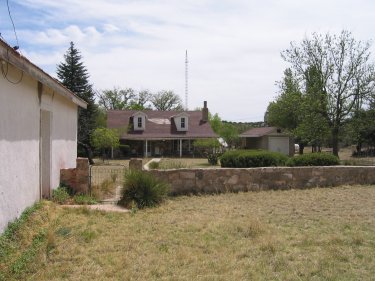
This house, seen from the Arabela road, was the Leopoldo Pacheco home. Native rock veneer was added to this adobe house after Leopoldo’s marriage to Pablita (Pauline) Fresquez Sisneros. That was the second marriage of both Leopoldo and Pablita; both had lost their first spouses to the 1918 influenza epidemic. The house is currently owned by their daughter, Sally Pacheco. Prior to his death in 1965, Leopoldo had a 50 section sheep ranch. The white stucco building in the foreground is the “new store with filing station gas pump” that replaced Leopoldo’s original “mercantile/feed store/post office, which is across from the “new” store.
RWM
Like the annual migration of monarch butterflies, and the return of swallows to Capistrano, cadets return each August to the campus of Roswell’s New Mexico Military Institute.
NMMI Public Relations officer, Major Nelson Miller, remarked to your editor during a late spring interview a couple years ago, that the heartbeat of the Institute stops when cadets depart at the end of the school term. That warm and poetic remark evoked a unique viewpoint. Spring is their fall when the Institute prepares for hibernation for their winter, which is summer when the cadets are gone. Fall is their spring with the rebirth of the Institute campus each new school year.
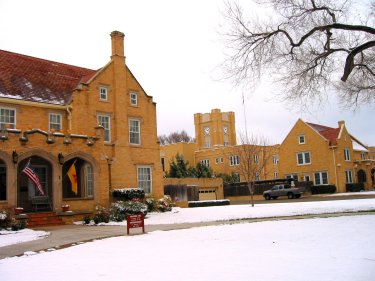
NMMI Superintendent’s Residence in the foreground and the Clock Tower and other campus buildings in the background. Photo taken January 1, 2002, the only snowfall of the year. Cadets were away on Christmas-New Year’s holiday. The campus was lifeless; it’s heartbeat had stopped but would soon beat again.
Roswell and the New Mexico Military Institute first welcomes to its campus the Bronco football players and its cadre, which are the old cadets designated to provide RAT leadership and training. The cadre spends several days in training and preparation for the arrival of the RATs. Then come the RATs, which is cadet slang for Recruits in Training. RATs are easily distinguished by their whitewalls — the closely clipped sides of their heads, never before exposed to sunlight. Whitewalled RATs are at first seen emerging a little uncertain, but one day, like butterflies coming back to a familiar place, they will return to Roswell as seasoned old cadets and cadre to prepare the new uncertain batch of incoming new cadets. Following RAT matriculation and RAT Week, the yearling and old cadets, who have already experienced some NMMI life, return and complete their matriculation. The school’s athletes quickly kick off the year with volleyball, soccer and football games.
New Mexico Military Institute is a state-supported school that operates under a Board of Regents appointed by the Governor. Its superintendent is its chief executive officer. The academic program is under the dean, and assistant dean who is also the high school principal.
The Corps of Cadets has its own chain of command responsible to the Commandant of Cadets and his/her staff. The Cadet Commandant exercises direct command supervision over the Corps of Cadets, and he and his staff are responsible to the superintendent for the organization, control, discipline, training, health and welfare of the Corps.
NMMI academically offers its cadets a high standard of high school and junior college education. The Corps is comprised of six classes, first through sixth; those are, in reverse order, high school freshmen (cadet 6th class), high school sophomores (cadet 5th class), high school juniors (cadet fourth class), high school seniors (cadet third class), college freshmen (cadet second class) and college sophomores (cadet first class).
Throughout its long history, NMMI has welcomed cadets from all parts of the world, and in 1977, welcomed its first female cadets since its earliest days as Goss Military Institute. New cadets meet many challenging experiences and requirements. Leading that list is to be a person of integrity, and to develop leadership skills. First, before becoming a leader, a cadet must learn to be a follower, to obey orders of his superiors. The moral or academic failure of a cadet reflects adversely upon all members of his troop and his superiors.
A cadet is taught social graces, to be courteous and to address adults formally. He is expected to succeed, to be proficient in every academic subject at the highest capable level, and to be the best that he can be physically and morally. Cadets must adhere to the NMMI Honor Code — they must not lie, cheat, steal, or engage in any form of academic dishonesty, nor tolerate those who do. Violation of the Honor Code might result in suspension or dismissal.
In other words, it is not easy being NMMI cadets, especially new ones, but they take away with them the education, lessons and leadership skills learned, and the close friendships acquired, into their military, graduate school, business or corporate futures, and those things remain with them the rest of their lives.
New Mexico Military Institute, began in 1891 by Joseph C. Lea as Goss Military Institute, has come a long way. It has had and continues to have a noble history and has produced, and will continue to produce, many nationally known athletes as well as noteworthy leaders in varied endeavors, not only on the military battlefield.
New Mexico Military Institute’s long-standing tradition of duty, honor and achievement has benefited not only the cadets of NMMI and the Roswell community, but has had far-reaching effects around the world for the majority of its 110 years.
***
In the past, your editor has been an ambassador parent to two or four cadets a year. The purpose of the Ambassador program, which is under the supervision of the Cadet Social Hostess, is to give cadets, especially new cadets from distant states and foreign countries, a sponsor in Roswell. During the rare times that cadets are given free time off post, it provides them a home environment, home-cooked meals and sense of family nearby. Far more cadets want to participate in this program than there are Ambassador families available. This opportunity to meet fine young men and women is a rewarding and recommended experience.
RWM
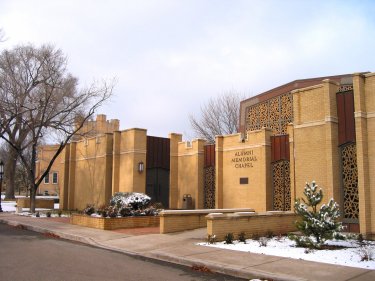
NMMI Alumni Memorial Chapel — photo taken Jan. 1, 2002
BEWARE
We have just received the following Virus Warning by Email:
Trojan Horse posed as Antivirus Upgrade: a virus in disguise is on the loose.
An Email claiming to be an antivirus program update instead contains a Trojan horse that automatically installs a virus. Kaspersky Labs is warning that an Email spoofs a Microsoft.com corporate Email account and claims to be an upgrade to the Kaspersky virus-fighting program, but contains a Trojan horse. Once clicked, the attachment installs a backdoor Trojan called Apher. The program gives a remote user access to affected computers, then automatically installs a virus called Backdoor.Death.25. For more information on this, see the ABC News article (the following link takes you to that article published on the Internet:
http://abcnews.go.com/sections/scitech/TechTV/techtv_trojanvirus02807.html
Below is a poem about another type of computer virus.
THE VIRUS DANCE
by Joyce Abrahamson
The other day a message came by e-mail just for me.
The subject line of love aroused my curiosity.
I should have left that mouse alone, I’m sorry I did click.
The one who sent their love to me, played me a dirty trick.
Hidden in the words of love that danced upon my screen
A malicious love virus danced in there unseen.
It danced into my documents and sent them far and wide.
Some to folks unknown to me, who angrily replied.
It danced into my address book and randomly chose names,
To receive the words of love that make computers lame.
I quickly sent a message out to all names on my list,
“Please don’t open mail from me, loves virus does exist.”
Then I clicked on disconnect to stop the virus dance,
But now the bug was in control, the PC had no chance.
I shut it down and pulled the plug and took it to the shop,
Hoping they would find the way to make the dancer stop.
I called them in the morning and I called again at noon
Hoping that my sick computer sure would be well soon.
“Your computer’s better now, of that I have no doubt.
It really was a tricky job to chase that virus out.”
Other words of wisdom the repairman said to me,
“Be sure your Norton’s up to date, so you’ll be trouble free.”
After my experience, these words I know are true,
Having a computer virus isn’t like the “flu.”
Who knows what evil lurks out there, just waiting for the chance
Of sneaking in with your e-mail to do a virus dance.
Captain Joseph C. Lea: From Confederate Guerrilla to New Mexico Patriarch, the new book by Elvis E. Fleming, is available at the Historical Society for Southeast New Mexico, 200 N. Lea Avenue, and also at Cobean’s Stationery, 320 N. Richardson Avenue, Roswell. The book sells for $25, with over 260 pages plus 66 illustrations. It was published by Yucca Tree Press in Las Cruces, in cooperation with, and to benefit, the HSSNM.
The author, Fleming, is city historian, member of and archivist for Historical Society for New Mexico, as well as Eastern New Mexico University-Roswell professor of history, emeritus.
Rwm
 Roswell Web Magazine
Roswell Web Magazine